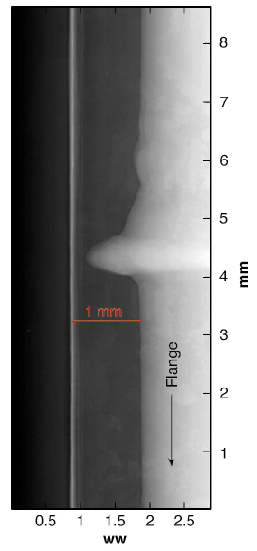- Home
- Users & Science
- Scientific Documentation
- ESRF Highlights
- ESRF Highlights 2005
- The X-ray Source
- Water Leaks and Crotches
Water Leaks and Crotches
Contrary to previous years, 2005 was marked by a number of water leaks. A water leak-to-air developed on the photon beam movable absorbers of a number of bending magnet and insertion device beamlines. These leaks affected only the oldest units in operation since 1992-1993. Remedies were found to limit the impact on user operation. A number of spare absorbers were ordered and delivered, enabling the replacement and repairs of the defective absorbers during the machine shutdowns. The process leading to this leak has been understood and is linked to the high pressure water flow which generates cavitation followed by erosion of the wall material in some sharp edge elbows made of copper. The replacement or repair of all defective ID absorbers is expected to be by the end of 2006. For the bending magnet absorbers, a repair is being made to save time and a new design of absorber has been produced and will soon be tested before purchasing a series.
The most severe failure, given its impact on user operation, was the water leak-to-vacuum of the cell-15 crotch absorber, which resulted in the venting of two cells of the ring in March 2005. Altogether 5 days of USM had to be cancelled and were rescheduled in October. The investigation showed that a flat cavity with narrow vertical height (~ 0.5 mm) had developed in the wall of the first tubes of the crotch. The cavity formed in the plane of the bending magnet radiation and is deeper in places where the copper was the thinnest. The leak occurred when the cavity breached the copper wall of the tube, originally a minimum of 1mm thick. The chemistry involved in this process can be qualitatively explained as follows. The hard X-ray beam from the bending magnet, having traversed 5 mm of copper, is still sufficiently intense to produce a high number of radicals or oxidant species with a short lifetime, which corrode the tube in the vicinity of the place where they are produced. This process is slow since it took 10 years to traverse the 1mm thickness of the copper tube. The question was raised concerning the state of all the other machine absorbers and in particular all 64 crotch absorbers located immediately after each bending magnet along the ring circumference. These crotches are built to the same design as the cell-15 crotch absorber. A normal crotch absorber from cell-6 was exchanged during summer and further investigated by non destructive radiography on the ID-15 beamline.
 |
|
Fig. 164: Radiography of the cell-6 crotch absorber observed on the ID15 beamline. The water flows from bottom to top. The white trace is the water channel in the tube while the grey part is the copper wall surrounding the tube It shows that a cavity has developed and propagated through the 1 mm thick copper tube. |
The radiography presented a similar cavity in the water tube but with a reduced penetration corresponding to an 0.25 mm residual wall thickness (see Figure 164). The reduced penetration of the cell-6 crotch absorber (compared to the cell-15 crotch) is understood from the 15% higher power density on the cell-15 crotch combined with a 9% lower effective copper thickness. A simple model based on the scaling of the power density and the X-ray transmission through the copper predicts that all 64 crotches should fail in a similar manner in the few years to come. To slow down the process, all crotches have been displaced vertically by 2 mm in such a way that the X-ray beam falls outside the existing cavities. Meanwhile, an order has been placed to replace all crotches with a modified design that would extend the lifetime beyond 50 years.



